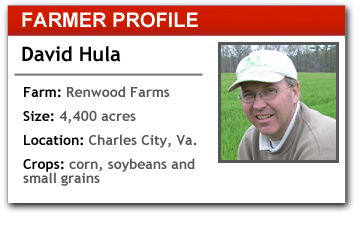|
Martha Ostendorf-Mintz, Contributing Writer
Seed producer and yield champion David Hula runs an intensely managed farm, making precision technology a natural fit.
His sprayer gets a lot of use applying herbicides and fungicides, so when Hula jumped from 60- to 90-foot booms he also did away with tramlines and started using auto-steer. The same went for his combines as headers got larger and larger.
“We wanted the operator to focus on equipment performance, not keeping a full header,” Hula says.
He uses John Deere auto-steer guided by SF1 signal, which has gotten better with the addition of more satellites. John Deere GreenStar3 yield monitors are used to create accurate maps and records of different hybrids.

“Collecting data is very important, especially in the seed business,” Hula says. “We use that yield data to help our customers, so that equipment has to be accurate.”
He’s also used Veris technology to help guide soil sampling and create prescription application maps for potash and lime based on yield goal and soil type. A Falcon 2 controller in Hula’s TerraGator spreader guides the variable rate applications.
“We didn’t increase yields, but we’re managing our inputs more effectively,” he says. “Some areas weren’t fertilized enough and we’ve reduced overall potash application.”
Somewhere between his start with lightbar guidance and today, Hula started working with Precision Planting. Initially they calibrated his meters, then he got the 20/20 SeedSense monitor.
“It allowed us to record our planter habits and help us manage recordkeeping,” he says. “Now we’ve taken it a step further incorporating the FieldView application on our iPad.”
While the 20/20 monitor gives a snapshot of what’s happening every second, FieldView collects all that information and reports performance for the field as a whole.
“The map on the iPad actually shows you all areas where there are 5% or fewer skips, giving you a bigger picture,” Hula says. “Then you can choose to adjust planting or just keep going.”
A new variable-rate planter arriving on the farm will give him even more control in 2013.
Points of Pain: Dialing in Actual Field Use
Precise performance and gathering accurate data is important to Hula and his ability to produce a quality, data-backed product to his seed customers. That’s why faulty setup is at the top of Hula’s concerns with his precision technology.
When planting or spraying, he’s come across the situation where the monitor is at one spot, the planter units are 15-feet behind it and the distance is programmed wrong so sections are shut off at the wrong time. He has also had issues with swath control on the sprayer.
“When you approach the headlands or the end of the field there are speed-based parameters for shutoffs,” he explains. “The dealer will set it up one way and then we don’t drive like they anticipated we would drive.”
Hula has been accused of driving too fast so when the booms cut on and off the lag time results in over- or under-application. But the issue, he feels, is a disconnect between farmers and dealers and how the technologies are actually used in the field.
“It’s a situation where the dealer needs to become more familiar with what we’re doing and how we’re using our equipment prior to setup so it can be calibrated more accurately before we even get into it,” Hula says.
To accomplish this, dealers may need to ask more questions on field operations up front, or even spend some time in the field with their customer.”
|